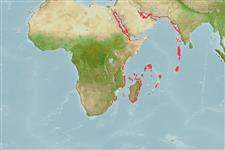>
Eupercaria/misc (Various families in series Eupercaria) >
Labridae (Wrasses) > Corinae
Etymology: Coris: Greek, kore, -es = pupil and also with themenaing of "maid" (Ref. 45335).
More on author: Rüppell.
Environment: milieu / climate zone / rango de profundidad / distribution range
Ecología
marino asociado a arrecife; rango de profundidad ? - 10 m (Ref. 100374). Tropical; 30°N - 30°S
Western Indian Ocean: endemic to the Red Sea. This name is wrongly used in the Indo-West Pacific for the very similar Coris batuensis.
Tamaño / Peso / Age
Madurez: Lm ? range ? - ? cm
Max length : 20.0 cm TL macho / no sexado; (Ref. 8883)
Occurs often on sand and rubble substrata in coral reef areas (Ref. 33411). Benthic predator (Ref. 33482).
Life cycle and mating behavior
Madurez | Reproducción | Puesta | Huevos | Fecundidad | Larva
Oviparous, distinct pairing during breeding (Ref. 205).
Randall, J.E., 1999. Revision of the Indo-Pacific labrid fishes of the genus Coris, with descriptions of five new species. Indo-Pac. Fish. (29):74 p. (Ref. 33411)
IUCN Red List Status (Ref. 130435: Version 2025-1)
Threat to humans
Harmless
Human uses
Pesquerías: comercial; Acuario: Comercial
Herramientas
Special reports
Download XML
Fuentes de Internet
Estimates based on models
Preferred temperature (Referencia
123201): 25.1 - 29.3, mean 28.1 °C (based on 227 cells).
Phylogenetic diversity index (Referencia
82804): PD
50 = 0.5000 [Uniqueness, from 0.5 = low to 2.0 = high].
Bayesian length-weight: a=0.00977 (0.00466 - 0.02049), b=3.07 (2.90 - 3.24), in cm total length, based on LWR estimates for this (Sub)family-body shape (Ref.
93245).
Nivel trófico (Referencia
69278): 3.5 ±0.37 se; based on food items.
Resiliencia (Referencia
120179): Medio, población duplicada en un tiempo mínimo de 1.4-4.4 años (Preliminary K or Fecundity.).
Fishing Vulnerability (Ref.
59153): Low vulnerability (10 of 100).
🛈
Nutrients (Ref.
124155): Calcium = 62.5 [24.1, 178.6] mg/100g; Iron = 0.669 [0.381, 1.255] mg/100g; Protein = 18.6 [15.7, 20.8] %; Omega3 = 0.125 [0.059, 0.253] g/100g; Selenium = 21.5 [8.1, 60.5] μg/100g; VitaminA = 137 [41, 502] μg/100g; Zinc = 2.3 [1.0, 4.2] mg/100g (wet weight);
